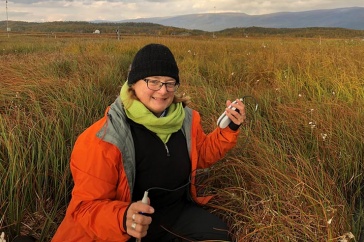UNH Receives $3.6 Million To Examine Climate Change Effect on Ecosystems

Ruth Varner, UNH professor of biogeochemistry is the co-director of a new NSF Biology Integration Institute (BII), called EMERGE, which will focus on better understanding ecosystem and climate interactions—like the thawing of the Arctic permafrost. Photo credit: Julie Bryce/UNH
DURHAM, N.H.— The University of New Hampshire is one of 14 universities from around the globe that have collectively been awarded $12.5 million by the National Science Foundation (NSF) to launch a new Biology Integration Institute (BII), called EMERGE. UNH will receive $3.6 million and will collaborative with the other universities to focus on better understanding ecosystem and climate interactions—like the thawing of the Arctic permafrost—and how they can alter everything from the landscape to greenhouse gases.
EMERGE, which stands for “EMergent Ecosystem Response to ChanGE,” is an ambitious five-year project that will concentrate on discovering how the processes that sustain life and enable biological innovation operate and interact within and between each other—from molecules to cells, species and ecosystems—under dynamically changing conditions. The end result will be a new “genes-to-ecosystems-to-genes” framework to create models that could help predict ecosystem response to change.
“Being able to predict how ecosystems respond to climate change is a pressing societal need,” said Ruth Varner, professor of biogeochemistry and co-director for EMERGE. “We have assembled a large interdisciplinary team to tackle the complex research questions that face our world today like whether thawing permafrost will result in emissions of the greenhouse gas methane and further accelerate climate change.”
The project will consist of a team of 33 scientists representing 15 scientific specialties. The partnership brings together expertise inside and outside of biology, such as ecology and evolution, organismal biology, team science, and modeling and computational science.
Research will be done in Stordalen Mire, a long-studied peatland in northern Sweden where permafrost thaw is driving changes in the landscape, plants and microbes. The scientists will examine how microbes react to a changing climate, as individual organisms, as a collective or community and how these evolve through time.
The institute, which will launch in September, will also have a strong training, education and outreach component for early career researchers, which Varner will lead, and will involve biologists at the postdoctoral, graduate and undergraduate levels.
UNH scientists involved in the research include Steve Frolking, research professor in Earth sciences; Michael Palace, associate professor in Earth sciences; and Jessica Ernakovich, assistant professor in natural resources and the environment. Those involved in planning and implementing the early career researcher training programs include Dan Howard, assistant professor in biological sciences; Melissa Aikens, assistant professor in biological sciences; Kate Siler, ADVANCE; and Erik Froburg, education and outreach specialist, UNH’s Leitzel Center.
Participating universities include The Ohio State University, University of Arizona, Florida State University, Colorado State University at Fort Collins, Case Western Reserve University, University of California at Berkeley, Rochester Institute of Technology, Lawrence Berkeley National Laboratory, Joint Genome Institute, all in the United States; Lund University, Umeå University and Stockholm University, all in Sweden; and Queensland University of Technology in Australia.
The University of New Hampshire inspires innovation and transforms lives in our state, nation and world. More than 16,000 students from all 50 states and 71 countries engage with an award-winning faculty in top-ranked programs in business, engineering, law, health and human services, liberal arts and the sciences across more than 200 programs of study. As one of the nation’s highest-performing research universities, UNH partners with NASA, NOAA, NSF and NIH, and receives more than $110 million in competitive external funding every year to further explore and define the frontiers of land, sea and space.
PHOTOS FOR DOWNLOAD
CAPTION: Ruth Varner, professor of biogeochemistry and co-director for EMERGE, walks on a boardwalk carrying gear with Martin Wik, Stockholm University, to a research site in the Stordalen Mire, a long-studied peatland in northern Sweden where permafrost thaw drives changes in the landscape, plants and microbes.
LINK: https://drive.google.com/file/d/11BWklr3PMUdkdwUEhyfYgXr9Zr6jhVoP/view
PHOTO CREDIT: Patrick Crill/Stockholm University
CAPTION: Boardwalks used to help researchers access key areas in the Stordalen Mire, a long-studied peatland in northern Sweden, collapse due to flooding from excessive permafrost thaw.
LINK: https://drive.google.com/file/d/1GQ8_qtvycg1G71h4MkF7kqvnG2W5GlOb/view
PHOTO CREDIT: Patrick Crill/Stockholm University
Latest News
-
December 12, 2024
-
December 11, 2024
-
November 22, 2024
-
November 7, 2024
-
October 30, 2024
















































